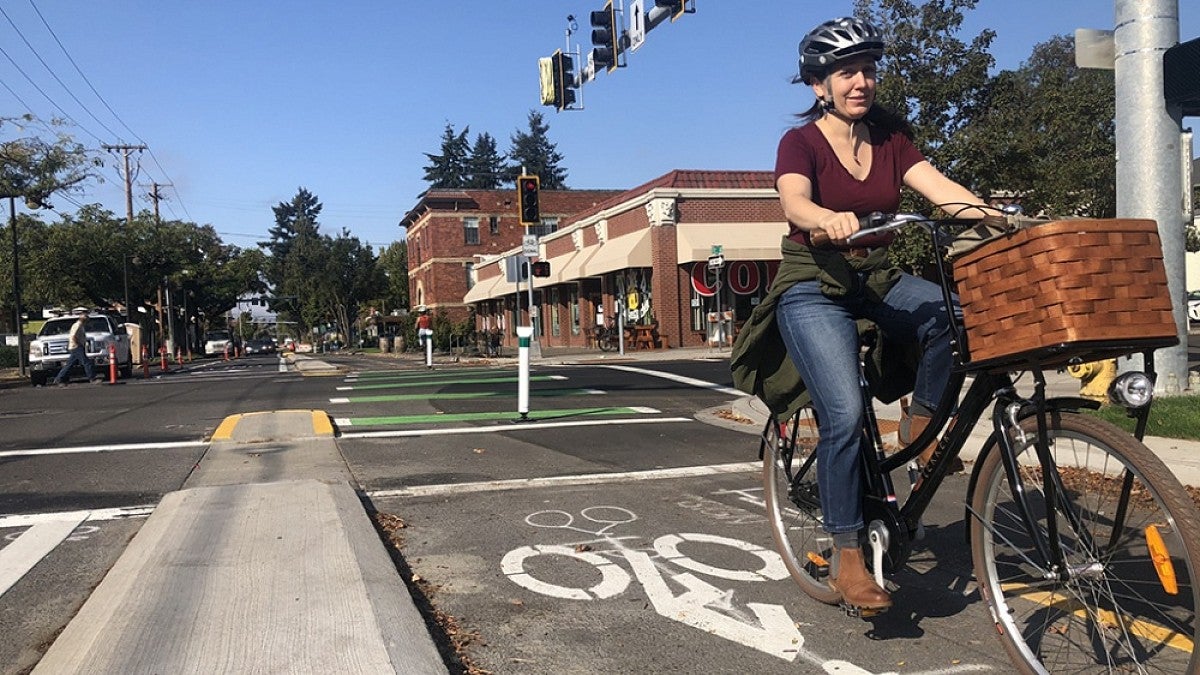In the history of the University of Oregon and city of Eugene, there had never been a plan to use East 13th Avenue as a thoroughfare connecting town and gown — at least by bicycle — said UO College of Design professor Marc Schlossberg.
That is, not until 2013, when students from LiveMove, a transportation and sustainability student group, came together to imagine a safer route for bicycle and pedestrian travel to and from campus on the busy one-way street that acts as the southern boundary of downtown Eugene.
Seven years on, the city of Eugene is hosting a weeklong celebration Oct. 23-30 for the opening of the 13th Avenue Bikeway, a two-way protected bike lane complete with 23 bike signals from Alder Street to Lincoln Street.
The week of celebration, which is open to the public, will include livestreaming events such as “The Intersection of Racism and Transportation” hosted by national transportation and planning expert Tamika Butler, a Bike Film Festival, and several group rides.
“We are excited that LiveMove’s vision for 13th has been realized and look forward to experiencing a safer, more enjoyable entrance to the UO campus,” said Nick Meltzer, who earned a master’s degree from the College of Design’s School of Planning, Public Policy and Management in 2014 and was one of the LiveMove students behind the original 2013 Downtown-Campus Corridor Concept Plan.
Reed Dunbar, a transportation planner and one of the designers for the bikeway, said it is the only protected urban bikeway in Eugene. A protected bikeway means there is a barrier between a car lane and a bike lane, in this case a 3-foot-wide by 6-inch-tall concrete divide. The safety feature was essential to the Eugene citizens who participated in city outreach about the proposed corridor.
“They don’t feel comfortable in a shared lane,” Dunbar said of those who commute by bike and alternative forms of transport. “They are afraid of the encroachment of cars.”
Community outreach for the project first began with LiveMove, which did a study of the East 13th Avenue and Hilyard Street intersection and found that a large percentage of cyclists were using unsafe workarounds to reach downtown from campus, like riding on sidewalks or biking the wrong way on what was then a one-way bike lane. With an increase in student housing downtown, LiveMove alumnus Joe McAndrew first identified East 13th Avenue as a problem area.
“As students that lived and traveled along the corridor, the LiveMove group noticed unsafe travel conditions for the thousands of students biking to and from campus along 13th Avenue,” said McAndrew, who graduated in 2013 with a master’s degree from the School of Planning, Public Policy and Management. “We also saw a huge opportunity for the city to better connect the bustling University of Oregon campus to the many retail and dining establishments within the downtown core.”
LiveMove conducted an analysis that included car and bike counts, physical conditions like lighting and signs, and the use of parking spaces along East 13th. The student group also held town hall presentations for their bikeway redesign concept, one of which became a pivotal moment for the project when Eugene residents John and Susan Minor attended.
“My husband John and I got involved in the 13th Avenue Bikeway project because our son David was killed in a bike accident at the intersection of 13th and Willamette in 2008,” Susan Minor said.
A “ghost bike” still stands at that intersection as a memorial to David Minor.
“The LiveMove proposal was the perfect solution, and to honor our son in a way that would protect others we contacted the city and donated $150,000 toward the construction of the bikeway,” Susan Minor said.
After the Minor’s donation, the city took up its own public process, building on LiveMove’s research, outreach and design concept.
“We ended up building it largely on community support, and that derives from LiveMove’s engagement with the community,” Dunbar said.
On Oct. 19, the city hosted a soft launch of the bikeway, with city staff observing how citizens used the new infrastructure.
“This accomplishment is important for LiveMove because it validates the work that we do,” said current LiveMove outreach coordinator Lexi Smaldone, a graduate landscape architecture student in the College of Design. “It pushes us students to strive for bigger, more complex projects and work towards promoting healthy, sustainable communities.”
Schlossberg, LiveMove’s faculty adviser, said the project shows how students can make contributions beyond campus.
“Students occupy a very unique space and capacity to put their knowledge and their passion to the benefit of the larger community,” he said.
He echoed Smaldone’s sentiment that the bikeway project created a better, healthier community, which fits well with the mission of the School of Planning, Public Policy and Management.
“For our discipline in PPPM, we are interested in the challenges of the day, in society, but that’s not enough,” he said. “We’re solution- and action-oriented.”
—By Alex Notman Cipolle, College of Design


